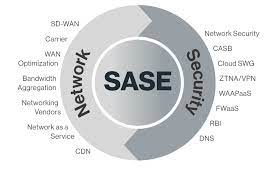It seems like there’s always a new acronym your enterprise needs to adopt in order to keep your networks safe from dangerous intrusions. As much as that might pain you from a spending perspective—sadly, it’s true. Without making the proper IT and security investments, organizations are setting themselves up for data loss.
Fortunately, there are solutions available that can keep enterprise networks safer from threats. The best of these platforms and services can even pay for themselves in months, not years, and create sustainable ROI. Though it might sound too good to be true, it’s not. The important thing here is distinguishing between what features are most important and what providers have the most trustworthy services.
It’s possible that, in your search for relevant network security platforms, you’ve come across SASE or SASE+. These are highly relevant security offerings that should be understood and potentially adopted by enterprises of all kinds. These are some of the things you need to know about SASE versus SASE+.
What Is SASE?
The term SASE stands for Secure Access Service Edge. To the uninitiated, these words put together mean about as much as modern art does to a cowboy. But when you unpack them within their context of network security, there’s a lot of meaning.
In order to understand SASE, you first have to know about SD-WAN. A software-defined wide-area network is essentially a virtual overlay of a physical network. This allows for more nuanced control and monitoring of the whole network from any location. A SASE offering will combine SD-WAN along with a suite of security tools, such as a secure web gateway and advanced firewall.
SASE can be a key addition to your enterprise network security because it combines an architecture-level solution with security tools. It really creates a strong, unified defense and operating environment. But there are still going to be discrepancies between how different providers deliver their SASE solution.
How Does SASE+ Go Beyond SASE?
It’s reasonable to wonder how SASE+ goes beyond regular SASE. After all, there must be something worthy of that extra plus tag. Organizations can get SASE+ through Open Systems, which provides its offering with an emphasis on unification of security, being cloud-driven, and backed by some of the best security experts on the planet.
These aforementioned qualities are some of the top things that customers look for when turning to SASE+ for their network security needs. But there are some more specific features that make SASE+ stand apart from the rest of the field:
- Ability to incorporate ZTNA – According to Gartner, “Zero trust network access (ZTNA) is a product or service that creates an identity- and context-based, logical access boundary around an application or set of applications.” In simpler terms, ZTNA makes it so your networks don’t inherent trust devices or users connecting to applications. The advanced SASE+ and ZTNA security combination can create a more airtight network with fewer rules.
- Create a more seamless network – Everyone has been affected by the Coronavirus to some degree. This created a lot of issues for the many organizations that had to abruptly shift to remote operations. Network security was and still is one of the biggest challenges here. Implementing SASE+ can enable a more seamless network connection, regardless of location, while also making it much safer for people to access enterprise networks on personal devices.
- Managed by experts 24-7 – Network threats never sleep. Your defenses can’t either. This is why SASE+ is staffed by world-class security engineers. No matter what issues might arise, or the time of day, you can be assured there will be top-tier support behind you.
SASE offerings have a lot to offer enterprises today. With the frequency and scale of cyberattacks constantly on the rise, organizations of all kinds need to do whatever it takes to secure their networks.
